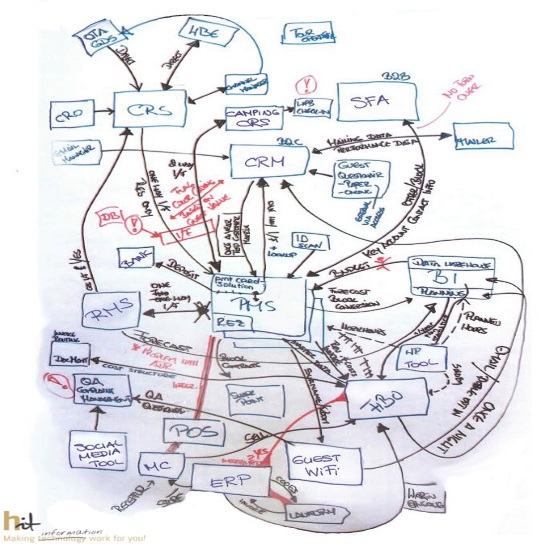
Untangling the spaghetti of hotel technology
By cameron in Uncategorized
A fly on the wall of a conversation about hospitality and hotel technology will almost invariably hear the word silos.
How are technology silos holding us back, for instance?
NB: This is an analysis by Margaret Ady, head of marketing for Snapshot.
Data silos are a barrier in any organization, but this term doesn’t adequately convey the true mess that the hospitality finds itself in.
The problem is that silos suggest order. Some logical grouping of like things. But this is hardly what we have in hospitality anymore.
Enter, Exhibit A!

The spaghetti chart illustrates the reality of the situation.
The PMS continues to be at the core, but channel management, revenue management, reservations software, CRMs, mobile technology, and the multitude of other tech pieces that come together to offer a whole administrative and guest experience swirl around the PMS haphazardly.
Hoteliers struggle just in managing the technology. Making good sense of highly valuable data buried deep in the spaghetti is virtually impossible.
And yet, a projection for 2017 is that hotels will begin interpreting their data usefully; it is the “ultimate intelligence”. It really is.
However, calls like this for hotels to focus on data science in order to do better at understanding the wealth of available information sometimes overlook an important step.
Spaghetti is different from pasta
Data organization must come first, and data organization begins with technology integration. Integration is often thought of as the merger of two systems; however, in the case of hotels, it must be considered as a process of creating, as the dictionary definition goes, “an integral whole”.
So this year, rather than skipping ahead to pie in the sky data interpretation – though this is certainly the ultimate goal – first we have to consider the framework that allows data to be understood.
That framework looks like a platform that brings the spaghetti into one well-organized strand of information that allows all the information to be understood within the context of the greater whole.
A technology ecosystem, an integral whole. An ecosystem such as this has one point of entry rather than 20 different log-ins.
It is a place where hoteliers can more easily make sense of key data that influences revenue management decisions, key distribution strategies, and customer relationship information because the ecosystem gives it context and make it instantly more usable.
Secret (spaghetti) sauce
The last several years have seen a lot of new ideas – some of them brilliant – around hotel technology.
Guest services technology such as smart room keys and electronic in-room concierge services.
Screen casting apps, room selection technology, and smartphone apps that facilitate reservations.
Mobile technology that allows hotel staff to better communicate. There are hundreds I could list here.
Sometimes these technologies are built into an existing technology, such as a PMS, and sometimes they integrate with one.
There is a risk that all of these added technologies take us further away from being able to truly serve the guest unless we harness the ability to integrate properly. Integration is the path to a strong foundation – one strand rather than a mess of spaghetti – and once we have achieved a strong foundation, we can make sense of the data that then allows us to better serve guests.
NB: This is an analysis by Margaret Ady, head of marketing for Snapshot.
NB2: Spaghetti image via Shutterstock.
![]()

